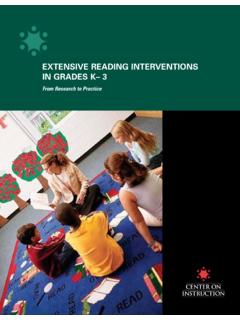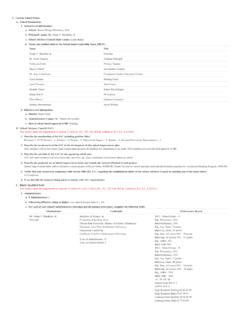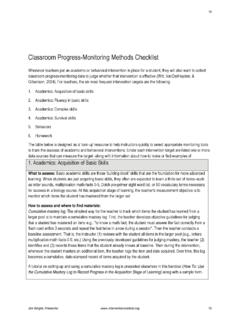Transcription of RTI: Selecting and Implementing Evidence-Based …
1 Carolyn Denton, Department of Pediatrics University of Texas Health Science Center Houston RTI: Selecting and Implementing Evidence-Based reading Interventions Current Understanding of reading Difficulties and Disabilities Core Principles of RTI Evidence-Based Instruction and Intervention for Primary-Grade Readers The Implementation of reading Interventions in RTI RTI in reading in Middle School Schools that Beat the Odds Current Understanding of reading Difficulties and Disabilities Children Do NOT Outgrow reading Difficulties A child who is a poor reader at the end of first grade has an almost 90% chance of remaining
2 A poor reader at the end of Grade 4 (Juel, 1988) and at least a 75% chance of being a poor reader as long as they are in school (Francis et al., 1995) ..unless we provide quality intervention! Francis et al. (1996) Students who are performing below grade level will only close the gap with their classmates if they learn FASTER than other students. More Instruction Efficient Instruction More Practice Keep in reading difficulty and disability Is variation on normal development (like high blood pressure or obesity, not the flu or cancer) Is caused and influenced by several different factors Ease of Learning to Read (Talent) The typical school approach to students with reading difficulties assumes that the problem is within the student and that this is a finite condition.
3 reading Disability By far the most common type is dyslexia Primary characteristic: Poor ability to read words, especially when presented in lists Primary underlying cause: Poor phonemic awareness (ability to hear and manipulate sounds in words), NOT seeing backwards Less common are disabilities in comprehension and speed of processing text (fluency) Comprehension Difficulties Many students with comprehension problems also have word reading problems even in middle and high school. Students with adequate word reading but poor reading comprehension also have problems with comprehending oral language Genetic: A Genetic Predisposition (about 60% heritable) Environmental: Economic disadvantage (health care, preschool education opportunities, etc.)
4 ; print exposure, parental literacy, oral language usage in the home and community, time spent reading to the child; not receiving appropriate instruction Neurological: Affected by both genetic and environmental influences Causes of reading Difficulties and Disabilities reading failure is caused by the interaction between features of instruction, the materials used, and student characteristics. reading Difficulties and the Brain The way the brain functions when doing reading tasks is different in people with serious reading difficulties (and in children at-risk for serious RD) and normally functioning readers.
5 But can this be changed? Neural Response to Intervention Does the pattern of brain activation change in response to intervention? 8 students with severe dyslexia 8 week intense phonologically- based intervention (2 hours a day= up to 80 hours of instruction) 1:1 in a reading clinic (during the summer) 2 hours a day = up to 80 hours of instruction Simos et al., Neurology, 2002 Demographic Information and reading Scores Child Gender Age (years/mo) WJ-III pre (%) WJ-III post (%) IQ Medication 1 M 15 13 55 103 Adderal 2 M 10 2 59 95 Ritalin 3 M 10 2 38 110 Ritalin 4 F 8 3 55 105 Ritalin 5 F 7 2 50 110 Ritalin 6 M 7 18 60 101 __ 7 M 11 1 38 98 Ritalin 8 M 17 1 45 102 __ The Power of INSTRUCTION Poverty IQ Family status Language levels Genetic predisposition Neurological processing patterns INSTRUCTION MAKES THE DIFFERENCE!
6 One-Sentence Reaction How might our current understanding of reading difficulties and disabilities affect practices in your school or classroom? Core Principles of Response to Intervention (RTI) Response to Intervention (RTI) is a comprehensive early detection and prevention strategy that identifies struggling students and assists them before they fall behind. RTI systems combine universal screening and high quality instruction for all students with interventions targeted at struggling students. Gersten et al., 2008 What Works Clearinghouse Institute of Education Sciences US Department of Education A 3-Tier Intervention Model Core Classroom reading Instruction Supplemental Intervention Intensive Intervention All students Approximately 20 30% of students Approximately 1% 10% of students Data documenting how a student responds to Evidence-Based , quality reading intervention may be used as a component of the process of identification of a reading disability.
7 Identification of Specific Learning Disabilities It is critical that educators view RTI as a school-wide, multi-tiered prevention/ intervention approach that is aimed at meeting the learning needs of ALL students, not just as part of the identification process for students with learning disabilities as referenced in IDEA 2004. Colorado Dept. of Education Exceptional Student Services Unit, 2006 Core RTI Principles We can effectively teach all students. Intervene as early as possible. Use a multi-tier model of service delivery.
8 Screen all students to locate those in need of intervention. Monitor student progress to inform instruction. Use data to make decisions. Data- based decision-making is central to RTI practices. When possible, use programs validated by scientific research. When research-validated programs are not available, use Evidence-Based interventions and instruction. What are research-validated programs? What Is Evidence-Based instruction? Teachers, want, above all, to provide instruction that makes a genuine difference in the lives of their children.
9 Lyon, 2000 Two Acceptable Standards Research-Validated Programs The programs or teaching approaches themselves were directly studied Research was of high quality Program demonstrated significantly better outcomes than a comparison condition More than one study found similar results Evidence-Based Programs and Practices Programs and teaching approaches have characteristics that are known to be effective for struggling learners. These characteristics are derived from converging evidence from multiple scientific studies. Evidence-Based Instruction According to the publishers, everything is research- based or Evidence-Based How can we really know what will work best for our students?
10 High-Quality reading Research Student Data Intuition Testimonials Poor-Quality or Biased Studies Evidence-Based Instruction High-quality scientific research controls for competing explanations for the findings so that you can trust the conclusions Random assignment and/or Matched groups with assessments before and after the intervention to equate the groups Evidence-Based Instruction Quality scientific research can indicate that a program is likely to be successful if it is implemented as it was in the study (with high fidelity) Research will not tell you what will work with every single child It can tell you what is more likely to work for most children Evidence-Based Instruction The use of teaching approaches that are not grounded in quality research and that result in a high percentage of students failing to learn to read is analogous to a surgeon choosing to perform a procedure that has a 19% mortality rate over one that has a 10% rate because (1) it is easier to do, (2) the surgeon is trained in it, and (3) the surgeon simply likes it better.





